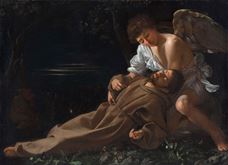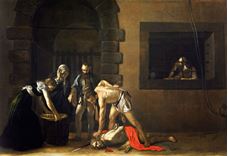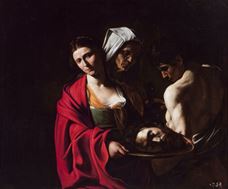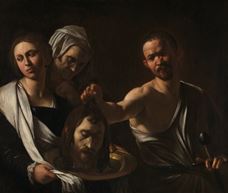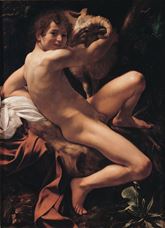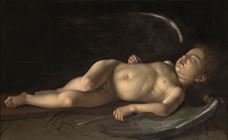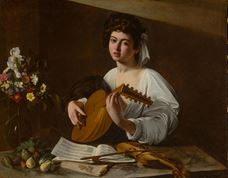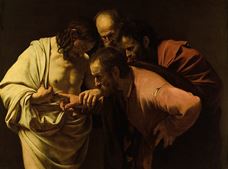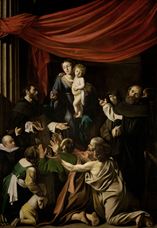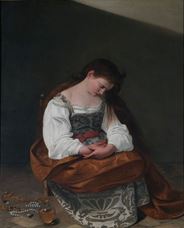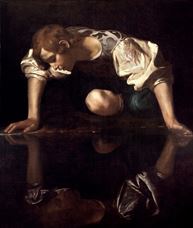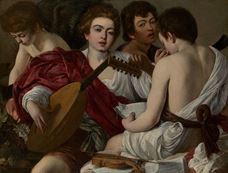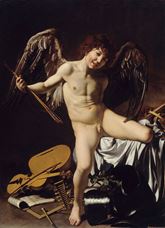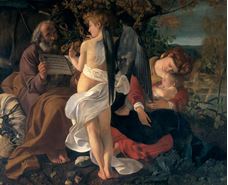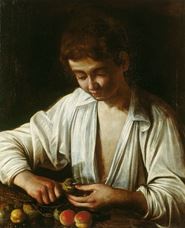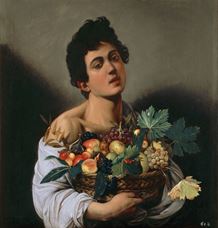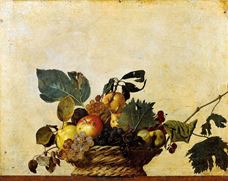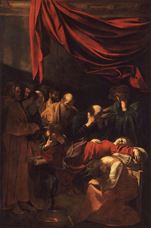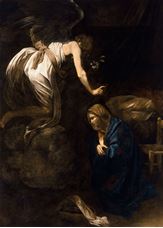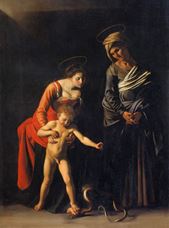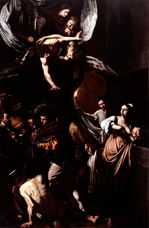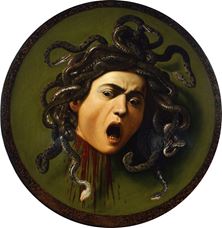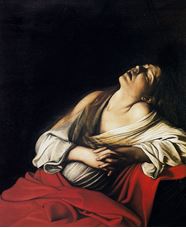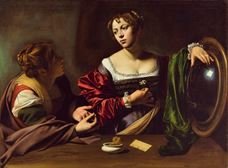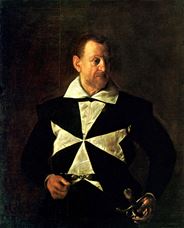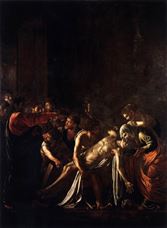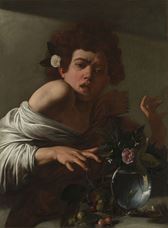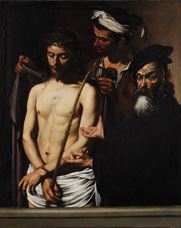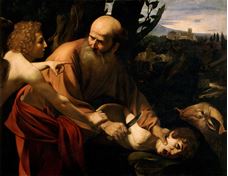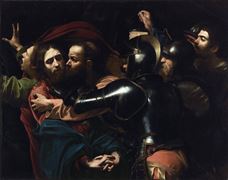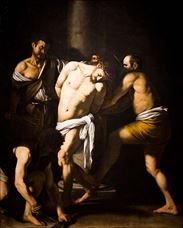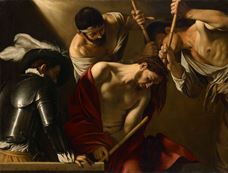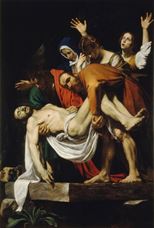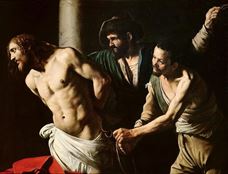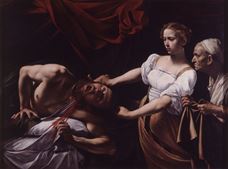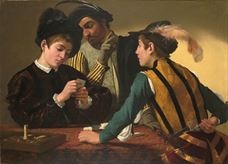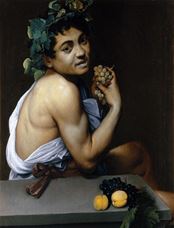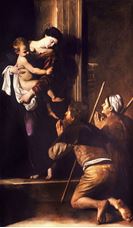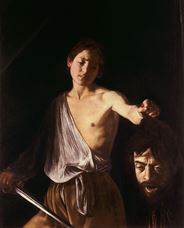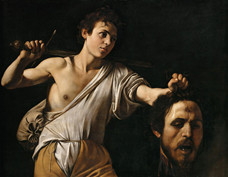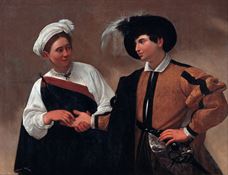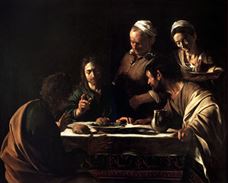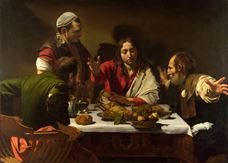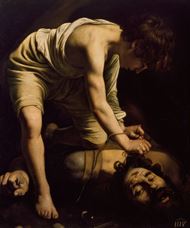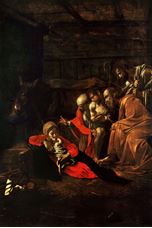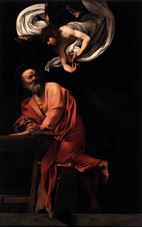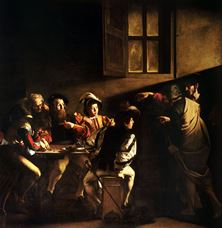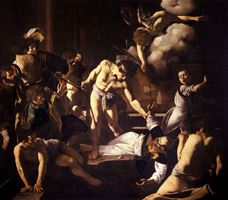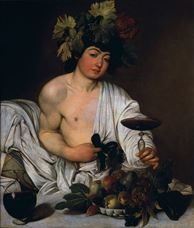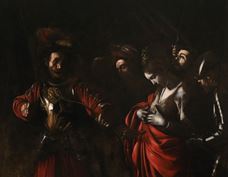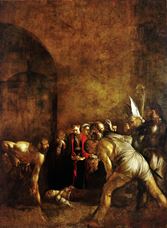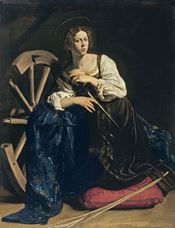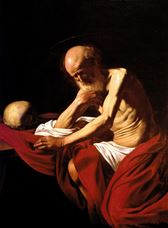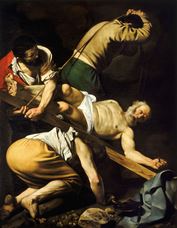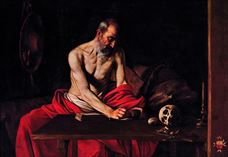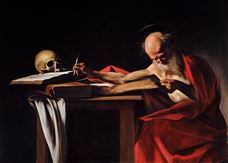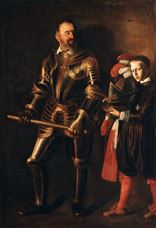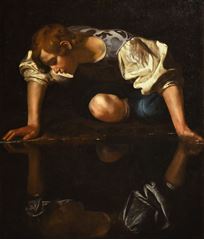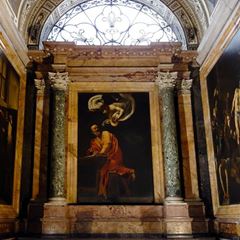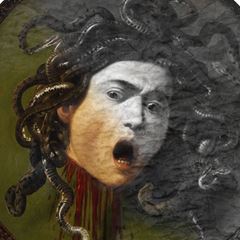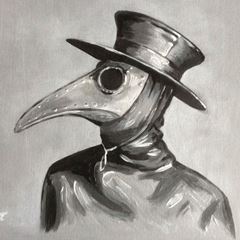Many epidemics have occurred in the world, and they will continue to come. Black Death, Black Plague or Great Plague Epidemic and Spanish flu are the most common epidemic diseases that cause death and destruction. Many Renaissance painters have brought this subject to their paintings.
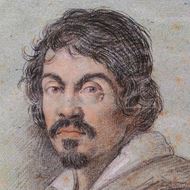
Caravaggio
Michelangelo Merisi da Caravaggio was born on September 29, 1571, in Milan. He was the first child of Fermo Merisi and Lucia Aratori. His father Fermo Merisi was working at the service of Francesco Sforza the Markiz of Caravaggio.
The family fled the plague that started in Milan and moved to the town of Caravaggio in 1576. Despite this, Caravaggio's father and grandfather died of plague.
Caravaggio lost his mother in 1584. That same year his passion for painting moved him to Milan when he was thirteen. He was apprenticed to the atelier of the famous painter Simone Peterzano from Bergamo, the student of Tiziano. His apprenticeship job was the first step of his career and the first stop of his own path to independence. At the end of his four-year apprenticeship period in 1588, he learned the use of brushes, saw many paintings and listened to the comments of the masters.
In 1592 Caravaggio went to Rome. He was considered to have left Milan for getting himself in trouble. From his early teens year, Caravaggio had a belligerent and angry character.
He settled in the atelier of the leading Rome painter Giuseppe Cesari (CavalieredepArpino). Cesari took on young, unheard talented painters, provided them with a living and employed them. He was only three years older than Caravaggio, and his career was a constant ascent. One of Caravaggio's most famous works is "Sick Bacchus", an extraordinary self-portrait that he describes himself as Bacchus. This young was the first of a series of characters to bring life to Caravaggio's main character's gallery. It was really taken and transferred but it was also a copy of the image reflected in a mirror, which was a subject that he would often return to in his work. In the same years, he detailed the painting "Boy Bitten by a Lizard" and in a short time, the use of paint became apparent for the first time with a light beam that would become a constant element of his paintings.
Caravaggio left Cesari's workshop eight months later. According to sources, the poorly wounded Caravaggio was left in a corner of the workshop by his masters and taken to Consolazione Hospital. The Cesaries did not visit him, which led to cut him off from the workshop.
Leaving Cesari, Caravaggio had focused on an independent career. He would no longer use his brush in the services of other painters. In this period, he had established important friendships with the painter Prospero Orsi, architect Onorio Longhi and sixteen-year-old Sicilian painter Mario Minniti. In 1595, Orsi found a place for him with Monsignor Fantino Petrignani and introduced him to the famous painting dealer, Constantino Spata.
Caravaggio was making his paintings from live models. Minniti, various peasants, gypsies, prostitutes, and children were among those who had posed for him for several hours in his workshop. He was exploring all the back streets of Rome and was interfering with street fights. He was usually inspired by the street in his paintings: "Good Luck", "The Cardsharps"… This was also a harbinger of a new ecole. These two works, the most important leap of his career, were bought in 1595 by a cardinal named Francesco Maria del Monte. Del Monte was a very curious collector. He was living in Palazzo Madama, the Florentine Medici, designed by Raffaello. He was serving as a political representative and art consultant for the Medici. Not only did he buy Caravaggio's paintings, but he also gave him a room at the Palazzo. This had brought order and stability to Caravaggio.
After Caravaggio settled at Palazzo Madama, his work had also changed. Cardinal, who was interested in music, had encouraged Caravaggio to music.
In 1599 he received his first important order with del Monte's mediation. He had undertook on the decoration of the Contarelli Chapel in San Luigi dei Francesi Church. The artist was only known around a small collector. It had been talked himself with the name that appeared in the night raids rather than on his paintings. While all the data were against Caravaggio, del Monte had reached the agreement of the parties and offered Caravaggio the opportunity of his life: "The Martyrdom of St Matthew", "The Calling of St Matthew", two years later, the third canvas "St Matthew and the Angel" he had painted. Caravaggio has suddenly gained a reputation with the exhibition of works and with the increase of his customers, he started to receive important orders. Caravaggio had also significantly changed the concept of chapel decoration. The use of traditional frescoes had been replaced by large canvases: sacred personalities were represented as living characters, and the religious significance of a tragic scene was successfully emphasized by the wise use of light. Even though the unified system of well-proven artists approached his work with prejudice, the young people adored him. These young people, who would be called "The Caravaggisti“, would ensure that his style would spread throughout Europe.
Five months after Contarelli's success, he received his first important order was the canvas of "The Crucifixion of Saint Peter" and "Conversion on the Way to Damascus" for the Cerasi Chapel in Santa Maria del Popolo.
Caravaggio produced masterpieces, but his private life had not stopped. His product ”Amor Vincit Omnia" for the cultural environment around Del Monte in 1602, in a short time the most demanded and famous were among the pictures. His reputation had spread all over Rome. Especially Giovanni Baglione, the rival of Caravaggio and the person who will be writing his biography in the future, made a picture that will be successful for the same collector environment. A series of poetry where Baglioni was humiliated and hurt, had been distributed with the help of the friends of Caravaggio. In September 1603 he was imprisoned with friends. In April 1604, he attacked the waiter with the growth of the discussion about the artichokes he brought to the table in a tavern. The injured waiter complained and in the summer of 1605 Caravaggio had found himself in court again. He had been found guilty with distorting the doors, stoning the old landlady's house, and severely damaging a notary.
On May 28, 1606, Caravaggio was involved in the most serious fight of his life. On a tennis court near Campo Marzio, he caused the death of his arch-rival, Ranuccio Tomassoni. This would cause him to leave Rome, where he could never return and disappear. The person who helped Caravaggio was thought to be Costanza Colonna. Costanza, who had known him for his childhood, was the widow of the Markiz of Caravaggio, the old boss of his father. It was said she was the secret organizer of Caravaggio.
In the autumn of 1606, he was in Naples where his fame was heard. At this time he was at the height of his fame and was welcomed as a master in Naples. He had taken many orders and devoted himself to his work. The following year, he put forward a new masterpiece that would turn into a reference for the entire Naples art community: "The Seven Works of Mercy". Again he made his famous work, "The Flagellation of Christ" during this period.
He went to Malta in July 1607 to receive the title of a privileged knight granted to the nobles. But there were two major obstacles in front of him. He did not come from the noble class and was a convicted criminal. The only advantage was that he was a talented and famous painter.
Caravaggio would live in Malta his longest stable period after Rome. But even as he focused on his most ambitious work, he had not given up hope of returning to Rome. In 1608, he was given the painting of the patron saint of the sect for the altar in the cathedral of the knights and painted the painting of "Beheading of Saint John the Baptist". It was the only painting he signed for. The table had achieved great success, and in July he had been admitted to the sect. Since he was a knight, he should have acted as a knight. But weeks later, he was involved in a fight and a knight was severely injured. The arrest warrant was issued for Caravaggio and thrown into the knight's most sheltered prison. But Caravaggio managed to escape from prison. He hadn't been captured and had gone to Sicily, even though the Knights had gone after him. Caravaggio was already a convicted criminal in the Papal State. Now he had angered one of the most powerful military and religious organizations in history.
He had appeared in Siracusa in October and had gone to his old friend Mario Minniti. Minniti was a well-known painter in the city. He was a blessing for Caravaggio who wanted to go back to Rome again to find a job. He received the order "Burial of St. Lucy" with the relations established by Minniti In December, he went to Messina.
He returned to Naples in 1609. Here again, he was on the agenda of a violent incident. He was attacked and seriously injured at the entrance of a bar. He was stabbed in his face and left aside thinking he had died. The attacker was unknown, but the painter was seriously injured. The Naples period was a productive process for Caravaggio. When he was able to hold the brush, he started to paint again. One of the most important works "David with the Head of Goliath" belonged to this period.
Caravaggio, who was eager to return to Rome awaiting pardon by the papal, set off from Naples to Rome in July 1610 with a ship. He had been forgiven, but the notice had not to reach Caravaggio. When they took a routine break at the port of Palo Laziale, there was a commotion and Caravaggio was detained. They were understood that there was a mistake, and he had gained freedom. But the ship carrying his paintings had gone away. He set out towards Porto Ercole to catch the ship. According to some sources, a deadly fire, while in others the heavy wounds of the attack in Naples led to his death.
The life of Michelangelo Merisi da Caravaggio's life full of adventure and success ended in Port Ercole on July 18, 1610.
Bibliography;
Erdoğan, C.E., (2015). Sanatın Büyük Ustaları Caravaggio, Birinci Baskı, Hayalperest Yayınevi, İstanbul.
Howard, A., (2017). İşte Caravaggio, Birinci Baskı, Hep Kitap, İstanbul.
D’Orazio, C., (2015). Caravaggio’nun Sırrı: Sanatın Gücü, İkinci Baskı, Dedalus Kitap, İstanbul.
Çev: Özbek, Ö., (2002). Artbook Caravaggio Işık ve Gölgenin Yaratıcısı, Dost Kitabevi, Ankara.
Aria, Ü.Ö., (2018). Caravaggio Dönemi-Yaşamı-Eserleri, Birinci Baskı, Hiperlink Yayınları, İstanbul.
Lunday, E., (2013). Büyük Sanatçıların Gizli Hayatları, Beşinci Baskı, Domingo Yayınevi, İstanbul.
Aria, Ü.Ö., (2018). Caravaggio Dönemi-Yaşamı-Eserleri, Birinci Baskı, Hiperlink Yayınları, İstanbul.
1571 He was born September 29, in Milan.
1576 He moved to Caravaggio with his family because of the plague. His father and grandfather died from plague.
1584 He lost his mother. In Milan, he entered the studio of Simone Peterzano, where he worked for four years.
1592 He settled in Giuseppe Cesari's (Cavaliere d (Arpino) atelier in Rome.
1594 His relationship with Cesari is over.
1595-98 He met Francesco Maria del Monte. “Cardinal "Good Luck" and "The Cardsharps" bought his works. He made works of "Lute-Player" and "The Musicians".
1598 He had been arrested several times for carrying unlicensed weapons while in the protection of Cardinal Del Monte. He made the paintings "Judith Beheading Holofernes" and "Narcissus".
1599 For the Contarelli Chapel in the Church of San Luigi dei Francesi, he was ordered two paintings on the life of St. Matthew.
1600 He was asked to make two paintings on "The Crucifixion of Saint Peter" and "Conversion on the Way to Damascus" for the Cerasi Chapel in Santa Maria del Popolo.
1602 He made the painting "Amor Vincit Omnia".
1603 Giovanni Baglione sued Caravaggio and his friends.
1604 A waitress complained to Caravaggio on the grounds that he was throwing a plate at his face.
1605 Trials: He was found guilty of distorting doors, throwing stones at the former landlady's house and severely damaging a notary.
1606 He caused Ranuccio Tomassoni to die in a fight. He escaped to Naples.
1607 He went to Malta.
1608 He painted "Beheading of Saint John the Baptist". He was accepted among the Knights of Malta and received the knight title. He was imprisoned because of a conflict. He escaped from prison. He was in Syracuse in October and in Messina in December. The knighthood was taken back.
1609 Messina'da "The Raising of Lazarus" and "Adoration of the Shepherds" began his works. He returned to Naples. He was seriously injured in an attack. He painted "David with the Head of Goliath".
1610 The Pope had reported forgiving him. He went ashore in Port Ercole in July to reach Rome. He died on July 18, 1610.
Narkissos - Caravaggio
Narkissos’un mitolojik öyküsü her çağda şairlere esin kaynağı olmuştur. Bunların en önde geleni Latin şair Ovidius’un Narkissos’u Ekho efsanesiyle birleştirdiği Dönüşümler’dir.
Contarelli Chapel - Caravaggio
Caravaggio undertook the decoration of the Contarelli Chapel of the Church of San Luigi dei Francesi. She paints "The Martyrdom of Saint Matthew" and "The Calling of St Matthew" for the decoration of the Contarelli Chapel. Two years later, the altar board is ordered to replace Cobaert's statue for the Contarelli Chapel. The third order Caravaggio received is "Saint Matthew and the Angel".
Medusa's Story - Caravaggio
Medusa was one of three sisters in Greek mythology known as the Gorgos. Her difference between her two sisters, Sthenno and Euryale, was that she was mortal. The main characteristic of these creatures, whose hair was woven with snakes, with wild pig teeth, bronze hands and golden wings, was to release fear. They were turning the one they looked into stone.













